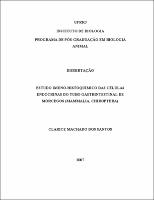Please use this identifier to cite or link to this item:
https://rima.ufrrj.br/jspui/handle/20.500.14407/10853| Tipo do documento: | Dissertação |
| Title: | Estudo imuno-histoquímico das células endócrinas do tubo gastrintestinal de morcegos (Mammalia, Chiroptera) |
| Other Titles: | Immunohistochemical study of endocrine cells in the gastrintestinal tube in bats (Mammalia, Chiroptera) |
| Authors: | Santos, Clarice Machado dos |
| Orientador(a): | Peracchi, Adriano Lucio |
| Keywords: | células endócrinas;imuno- histoquímica;tubo gastrintestinal;morcegos;endocrine cells;imunnohistochemical;gastrintestinal tube;bats |
| Área(s) do CNPq: | Morfologia |
| Idioma: | por |
| Issue Date: | 26-Mar-2007 |
| Publisher: | Universidade Federal Rural do Rio de Janeiro |
| Sigla da instituição: | UFRRJ |
| Departamento: | Instituto de Ciências Biológicas e da Saúde |
| Programa: | Programa de Pós-Graduação em Biologia Animal |
| Citation: | SANTOS, Clarice Machado dos.Estudo imuno-histoquímico das células endócrinas do tubo gastrintestinal de morcegos (Mammalia, Chiroptera). 2007. 60 f. Dissertação (Mestrado em Entomologia) - Instituto de Ciências Biológicas e da Saúde, Universidade Federal Rural do Rio de Janeiro, Seropédica - RJ, 2007. |
| Abstract: | Este trabalho visou analisar a influência do hábito alimentar na distribuição regional e freqüência relativa das células endócrinas secretoras de colecistoquinina, gastrina, serotonina e enteroglucagon nos morcegos insetívoros (Lonchorhina aurita e Molossus molossus), frugívoros (Artibeus cinerius e Sturnira lilium), nectarívoros (Anoura geoffroyi e Glossophaga soricina) e hematófago (Desmodus rotundus). Foram utilizados ao todo vinte e quatro animais, coletados durante a noite, com auxílio de redes japonesas ou puçá e tarrafas em diversos pontos, da reserva do Tinguá em Nova Iguaçu (Rio de Janeiro) e caverna casa de Pedra (SE-01) Fazenda Santo Antonio, Itabaiana (Sergipe). Fragmentos de duas regiões do estômago (fundo e piloro) e três fragmentos do intestino (duodeno, jejuno/íleo e intestino grosso) foram removidos, fixados, processados e em seguida submetidos à imunohistoquímica. Quatro tipos de células imunoreativas (IR) para serotonina (5-HT), gastrina (GAS), colecistoquinina (CCK) e enteroglucagon (GLUC) foram identificadas na mucosa gástrica e intestinal das espécies estudadas. Sendo as células imunoreativas a 5-HT, GAS, GLUC identificadas no estômago e as células IR a 5-HT, CCK e GLUC identificadas no intestino. A distribuição regional e freqüência relativa das células endócrinas variaram conforme as espécies e hábito alimentar. As células IR a serotonina foram encontradas ao longo de todo o tubo gastrintestinal, sendo o tipo celular predominante. As células IR a gastrina foram abundantes e fortemente marcadas na região pilórica de todas as espécies estudadas, sendo a maior freqüência relativa encontrada nos morcegos frugívoros. As células IR a CCK foram observadas ao longo do intestino de todas as espécies estudadas, variando apenas a sua freqüência relativa. Sua distribuição pode ser observada tanto nas glândulas intestinais, como entre as células epiteliais de revestimento. As células IR ao enteroglucagon apresentaram menor freqüência relativa quando comparadas às outras células endócrinas. Houve diferenças na distribuição e na freqüência relativa das células endócrinas do tubo gastrintestinal dos animais de mesmo hábito alimentar. Entretanto, estas diferenças foram menores quando comparadas com os animais de hábitos alimentares diferentes. |
| Abstract: | This work aimed to analyze the influence of feeding habits on the regional distribution and relative frequency of cholecystokinin, gastrin, serotonin and enteroglucagon secreting endocrine cells in insectivorous (Lonchorhina aurita, Molossus molossus), frugivorous (Artibeus cinerius, Sturnira lilium), nectarivorous (Anoura geoffroyi, Glossophaga soricina) and hematophagous (Desmodus rotundus) bats. Twenty-four animals collected at night with mist nets and hand nets in various places of Tinguá Reserve in Nova Iguaçu (Rio de Janeiro State) and Casa de Pedra Cave (SE-01) at the Santo Antonio Farm in Ribeira (Sergipe State) Brazil were used. The bats were sacrificed and two regions of the stomach (fundic and piloric) and three regions of the intestine (duodenum, jejunum/ileum and large intestine) were removed and cut in smaller fragments. Four types of immunoreactive (IR) cells to serotonin (5-HT), gastrin (GAS), colecystokinin (CCK) and enteroglucagon (GLUC) were identified in gastric and intestinal mucosa. The 5-HT, GAS and GLUC-IR cells were identified in the stomach. The 5-HT, CCK and GLUC-IR cells to were found in the entire intestine. The regional distribution and relative frequency of endocrine cells varied according to animal species and feeding habits. Immunoreactive cells to 5-HT were found throughout the entire gastrintestinal tube which were the predominant cellular type. The gastrin-IR cells were numerous and strongly labeled in the pyloric region of all species. The CCK-IR cells were observed throughout the intestine of all species, varying only in relative frequency. Their distribution could be observed in the intestinal glands as well as among the surface epithelium. The GLUC-IR cells had lower relative frequency when compared to the other endocrine cells. In this study, interspecific differences were observed between animals with the same feeding habits, but these were less when compared to animals with different feeding habits. This suggests, then, a correlation betweens the distribution and frequency of endocrine cells and feeding habit. |
| URI: | https://rima.ufrrj.br/jspui/handle/20.500.14407/10853 |
| Appears in Collections: | Mestrado em Biologia Animal |
Se for cadastrado no RIMA, poderá receber informações por email.
Se ainda não tem uma conta, cadastre-se aqui!
Files in This Item:
| File | Description | Size | Format | |
|---|---|---|---|---|
| 2007 - Clarice Machado dos Santos.pdf | 897.27 kB | Adobe PDF |  View/Open |
Items in DSpace are protected by copyright, with all rights reserved, unless otherwise indicated.

